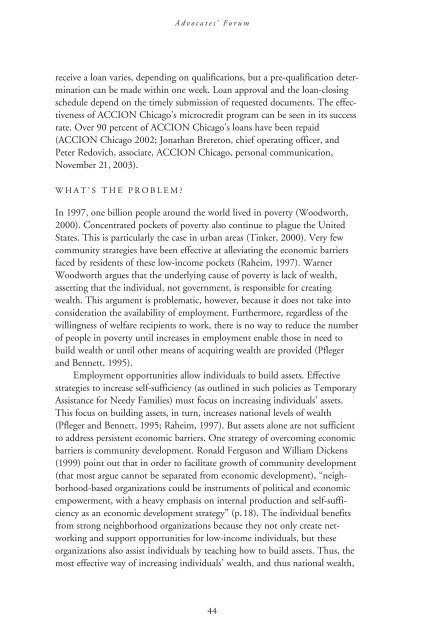2004 - School of Social Service Administration - University of Chicago
2004 - School of Social Service Administration - University of Chicago
2004 - School of Social Service Administration - University of Chicago
Create successful ePaper yourself
Turn your PDF publications into a flip-book with our unique Google optimized e-Paper software.
Advocates’ Forum<br />
receive a loan varies, depending on qualifications, but a pre-qualification determination<br />
can be made within one week. Loan approval and the loan-closing<br />
schedule depend on the timely submission <strong>of</strong> requested documents. The effectiveness<br />
<strong>of</strong> ACCION <strong>Chicago</strong>’s microcredit program can be seen in its success<br />
rate. Over 90 percent <strong>of</strong> ACCION <strong>Chicago</strong>’s loans have been repaid<br />
(ACCION <strong>Chicago</strong> 2002; Jonathan Brereton, chief operating <strong>of</strong>ficer, and<br />
Peter Redovich, associate, ACCION <strong>Chicago</strong>, personal communication,<br />
November 21, 2003).<br />
WHAT’S THE PROBLEM<br />
In 1997, one billion people around the world lived in poverty (Woodworth,<br />
2000). Concentrated pockets <strong>of</strong> poverty also continue to plague the United<br />
States. This is particularly the case in urban areas (Tinker, 2000). Very few<br />
community strategies have been effective at alleviating the economic barriers<br />
faced by residents <strong>of</strong> these low-income pockets (Raheim, 1997). Warner<br />
Woodworth argues that the underlying cause <strong>of</strong> poverty is lack <strong>of</strong> wealth,<br />
asserting that the individual, not government, is responsible for creating<br />
wealth. This argument is problematic, however, because it does not take into<br />
consideration the availability <strong>of</strong> employment. Furthermore, regardless <strong>of</strong> the<br />
willingness <strong>of</strong> welfare recipients to work, there is no way to reduce the number<br />
<strong>of</strong> people in poverty until increases in employment enable those in need to<br />
build wealth or until other means <strong>of</strong> acquiring wealth are provided (Pfleger<br />
and Bennett, 1995).<br />
Employment opportunities allow individuals to build assets. Effective<br />
strategies to increase self-sufficiency (as outlined in such policies as Temporary<br />
Assistance for Needy Families) must focus on increasing individuals’ assets.<br />
This focus on building assets, in turn, increases national levels <strong>of</strong> wealth<br />
(Pfleger and Bennett, 1995; Raheim, 1997). But assets alone are not sufficient<br />
to address persistent economic barriers. One strategy <strong>of</strong> overcoming economic<br />
barriers is community development. Ronald Ferguson and William Dickens<br />
(1999) point out that in order to facilitate growth <strong>of</strong> community development<br />
(that most argue cannot be separated from economic development), “neighborhood-based<br />
organizations could be instruments <strong>of</strong> political and economic<br />
empowerment, with a heavy emphasis on internal production and self-sufficiency<br />
as an economic development strategy” (p.18). The individual benefits<br />
from strong neighborhood organizations because they not only create networking<br />
and support opportunities for low-income individuals, but these<br />
organizations also assist individuals by teaching how to build assets. Thus, the<br />
most effective way <strong>of</strong> increasing individuals’ wealth, and thus national wealth,<br />
44
















